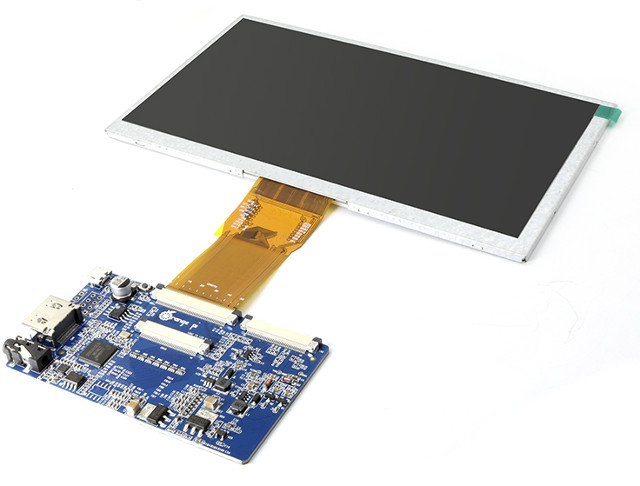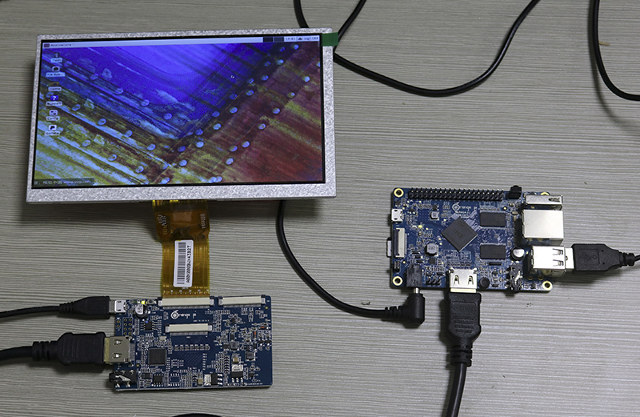If you want a cheap and simple way to add a screen to your development board, there are some 7″ displays with HDMI inputs that costs under $30 shipped. But Shenzhen Xunlong has decided to make their own 7″ LCD display with HDMI input and audio output, and sell for $22 + shipping.
 The company only provided minimal technical information about the board and display:
The company only provided minimal technical information about the board and display:
- Display – 7″ TFT LCD with 1024×600 resolution
- Video & Audio Input – HDMI
- Audio Output – 3.5mm audio jack
- Power Supply – 5V via micro USB port
If we look at a closer picture of the board, we’ll see they used Lontium LT8619B, but the company’s website is down… The board also features three different connectors for displays, so they probably have other displays planned. While the company claims the display is made for Orange Pi H3 boards, it should really work with any board that can output 1024×600 over HDMI.

All you need to use the kit is a board, a HDMI cable (preferably less than 1.5 meters), and a USB power supply for the “transfer” board and the display. It should also be possible to connect speakers via the 3.5mm audio jack. As usual, no documentation is provided, but I would not expect too many issues as long as the hardware works.

Jean-Luc started CNX Software in 2010 as a part-time endeavor, before quitting his job as a software engineering manager, and starting to write daily news, and reviews full time later in 2011.
Support CNX Software! Donate via cryptocurrencies, become a Patron on Patreon, or purchase goods on Amazon or Aliexpress





Nice once .. especially the LCD adapter with different pin type
Good luck with display drivers that do not support EDID properly or the signal board not providing correct EDID values. At least with H3 legacy kernel there is neither EDID nor a 1024×600 pixel HDMI solution and when I tried to get such a 1024×600 display working on an A20 board with legacy kernel a while ago I had to develop settings/timings myself (since only Raspberry settings for /boot/config.txt available that work nowhere else): http://forum.lemaker.org/thread-15430-1-1.html
I notice friendlyelec use a totally different approach on their 4418, 6818 based boards LCD .
http://www.friendlyarm.com/index.php?route=product/product&product_id=167
chip is lontium LT8619B ( http://cn.lontiumsemi.com/uploadfiles/pdf/LT8619B_Product_Brief.pdf ) , from the specs sheet it supports scaling so probably should be easier to support than fixed resolutions modules. pity there is no touch (initial page listed it as a touchscreen..). another downside is lack of mounting holes and hdmi port not aligned (so one cant easily put both board and sbc underneath, side by side)
If you try to figure out why it already gets easy. These FriendlyELEC boards use tablet SoCs that can natively talk to LCDs whereas this Xunlong screen targets boards using TV box SoCs that are equipped with HDMI only. Allwinner’s H series can *not* access LCDs natively so such a HDMI signal board is needed. Xunlong’s board will of course run with every HDMI capable device but it’s still a matter of resolution/timings (and EDID or not) whether you’ll be happy with the display or not. These HDMI signal boards usually can cope with different than native resolutions but 1024×768 for example will look pretty crappy when scaled to 1024×600 native resolution and with 720p or 1080p most stuff will be too tiny to have fun with such a display anyway. It all boils down to a driver issue (and/or EDID).
For me much better option (and cheaper) was to make use of dead laptop’s 17″ LCD panel + driver board for it ($30 with shipping i think). DVI, HDMI and VGA inputs and 3.5mm jack for audio out (from HDMI) 🙂 That’s if you have or can get dead laptop with good display.
The first thing I always look for is reliability info. If it is missing, that tells me that it probably shouldn’t be considered for use in a real product.
Cheap is good for hobby use. But in production, after it runs 24/7 for a few months, does it still work? If so, can you still read it?
@Stane1983
I have found cheaper edition. V59 or V29 LCD controller cost about 10$ with 15″ LCD from dead laptop. So this is practically free.
A 5″ version of the display has been launched for $19.80 -> https://www.aliexpress.com/store/product/5inch-TFT-LCD-Screen-for-H3-chip-Orange-Pi-Boards/1553371_32832986543.html
@OvCa77
Do you have any links to such driver boards? I too have some screen from laptops .)
@stane1983